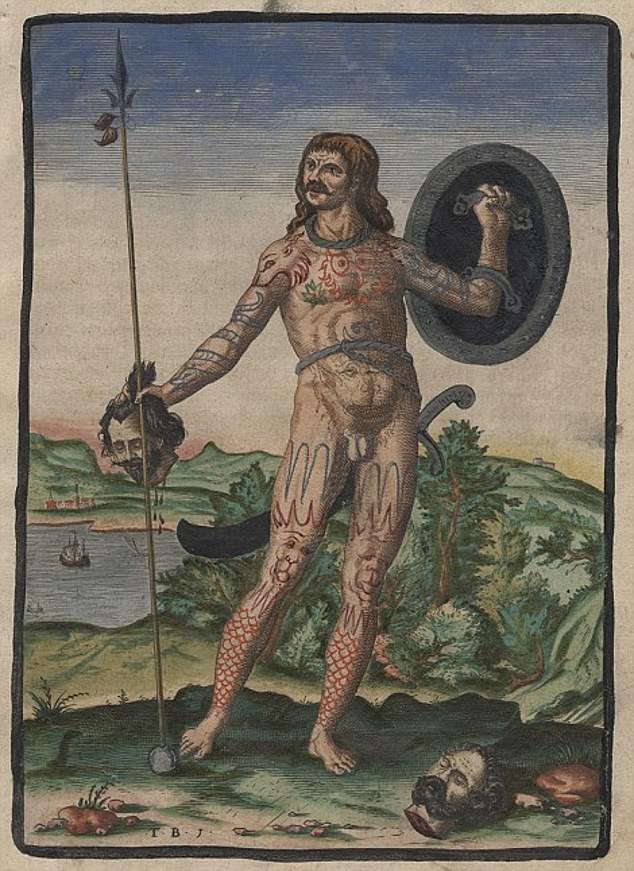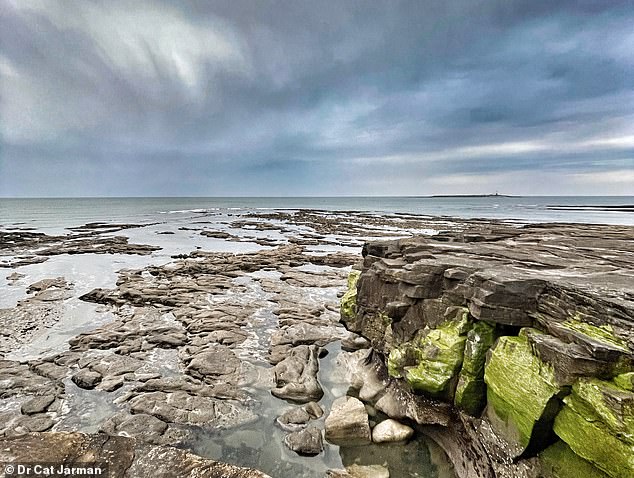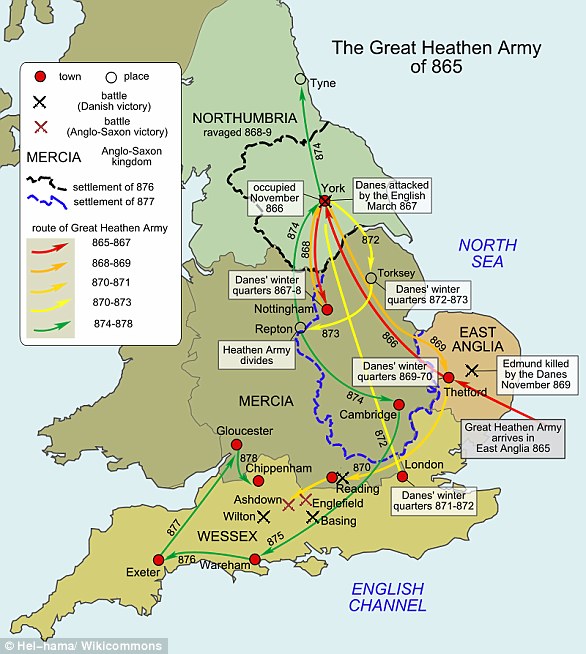Viking Great Army launched devastating raids on Celtic Picts from massive hilltop camp in Northumbria, experts say
- Site in Coquet Valley was likely base of Viking commander Halfdan
- Amateur metal detectorists have previously found gaming counters and coins
- Now experts say the finds confirm medieval accounts of Viking raids on Picts
- The hilltop base was perfect location for the Vikings to base themselves
25 May 2021
A Viking Great Army camp discovered on a Northumbrian hilltop gives physical backing to early chroniclers' accounts of raids against the Celtic Picts, experts say.
The 49-hectare site in the Coquet Valley, Northumbria, has been explored by metal detectorists for the past 15 years.
They have found artifacts including gaming counters, coins and other items which indicate the presence of the Vikings.
Now, archaeologists currently working at the site say the finds confirm written accounts describing what happened after the Great Army split in two following its conquest of the Anglo-Saxon kingdom of Mercia.
Oxford University archaeologist Dr Jane Kershaw said it adds physical evidence to a sole written account describing how an army under the Viking commander Halfdan ravaged territories including those of the Picts in today's Northumberland.
Speaking on History Hit's Gone Medieval podcast, the expert said there was a 'very brief historical reference that Halfdan was on the Tyne and raided among the Picts and Strathclyde Britons and that's all we've known'.
The site, which has not been publicly identified to prevent it from being looted, is the furthest north of the Great Army camps which have been found.
Halfdan chose it because it is on a steep hill and would have been protected by water whilst giving good views towards the coast and surrounding hills, Dr Kershaw said.
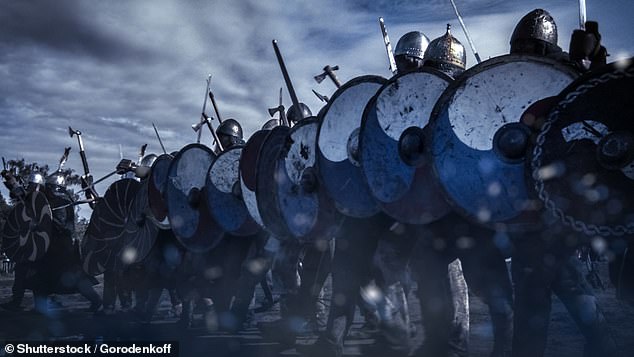
A Viking Great Army camp discovered on a Northumbrian hilltop gives physical backing to early chroniclers' accounts of raids against the Celtic Picts, experts say (file photo)
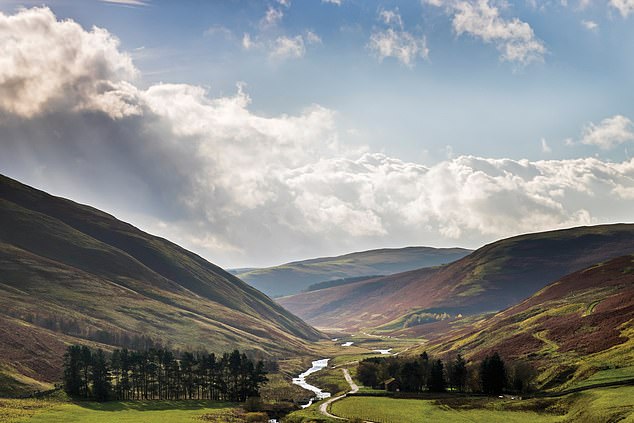
The 49-hectare site in the Coquet Valley, Northumbria, has been explored by metal detectorists for the past 15 years
The riverside location would also have allowed the Vikings to retreat quickly if they had needed to.
The Viking Great Army, also known as the Great Heathen Army, invaded the four Anglo-Saxon kingdoms that made up England in 865AD.
Camps have previously been found at Repton in Derbyshire, Torksey in Lincolnshire and Aldwark in North Yorkshire.
Who were the Picts?
The Picts were a collection of tribes who lived in what is today northern England and eastern and northern Scotland during the Late Iron Age and early Medieval periods from around 270-900AD.They formed a tribal confederation whose political motivations derived from a need to ally against common enemies such as the Britons and the Romans.
They have long been seen as fearless savages who fought off Rome's toughest legions and refused to surrender their freedoms to live in conventional society.
However, this wild reputation might well be undeserved.
The Roman name for the people - Picti - means 'painted people'. It's not known what they called themselves.
Mel Gibson's blue face paint in Braveheart is a nod to the Pictish tradition of body-paint - but the real Picts fought stark naked, and there are records of them doing so up until the 5th Century.
The habit of fighting naked, especially in the cold Scottish climate, didn't harm the tribe's reputation for ferocity.
Picts held the territory north of the Firth of Forth in Scotland - and were one of the reasons even heavily armoured Roman legions could not conquer Scotland.
The Picts mysteriously disappear from written history around 900AD.
Experts suggest that they likely merged with southern Scots, who already had a written history by that time, and the two clans' histories combined.
Dr Kershaw told podcast host and fellow archaeologist Dr Cat Jarman that the finds of gaming counters at the Coquet Valley site showed how the Vikings enjoyed board games.
The coins found there were minted in the 860s, adding further weight to it having been a Viking camp.
Dr Kershaw said: 'People had never really looked for anything this far north. North of the Tees you have very few Scandinavian place names, hardly any artefacts, very few burials, so it's not an area we think the Vikings influenced.
'Not only are we north of the Tyne, we're 20 miles north of that again.'
The expert said the site is 'naturally defensive', making it a prime location for the Vikings to base themselves.
'It is an area of high ground with quite steep falls on at least three sides. [There is] easy access to the river which is great for looking out and keeping an eye on potential enemies,' she said.
'And it also gives you access if you need to get out to the coast to get away.'
Dr Jarman, who is part of the team which is continuing to excavate at the site, added: 'We might find some burials.
'One of the really interesting things about this site is that it was not just occupied in the Viking age.
'There is evidence for earlier high-status Anglo-Saxon activity. Going back even earlier there is Roman activity.'
Dr Jarman, the author of recent a recent book about the Vikings called River Kings, said the Coquet Valley site was identified as a former camp thanks to years of finds being reported to the Portable Antiquities Scheme.
Experts also used what is known as a LidarCor laser-scanning survey to give them an idea of how the site would have once looked when river levels were higher.
Halfdan Ragnarsson was the Viking leader who commanded the Great Heathen Army when it invaded the Anglo-Saxon kingdoms.
He became the first King of Northumbria before being killed at the Battle of Strangford Lough, in what is now Ireland, in 877.
Norse sagas say he was one of six sons of legendary Viking Ragnar Lodbrok. Chroniclers describe how Lodbrok distinguished himself via repeated raids on Britain in the ninth century.

They have found artefacts including gaming counters (pictured), coins and other items which indicate the presence of the Vikings. Now, archaeologists currently working at the site say the finds confirm written accounts describing how the Vikings ravaged the Picts in today's Northumberland
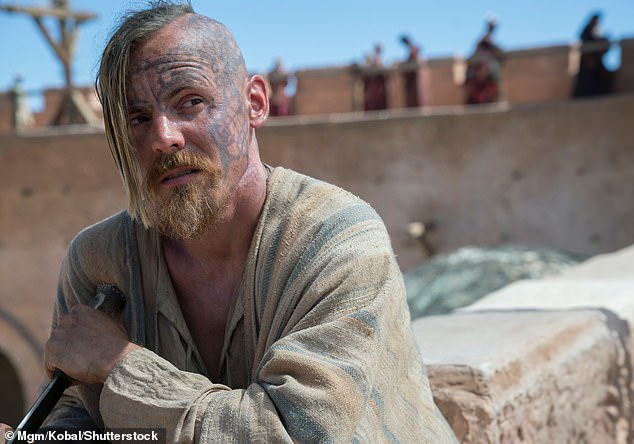
Speaking on History Hit's Gone Medieval podcast, the expert said there was a 'very brief historical reference that Halfdan was on the Tyne and raided among the Picts and Strathclyde Britons and that's all we've known'. Pictured: Jasper Paakkonen as Halfdan the Black in TV show Vikings

The Coquet Valley site is one of four Viking Great Army camps which have been found in Britain
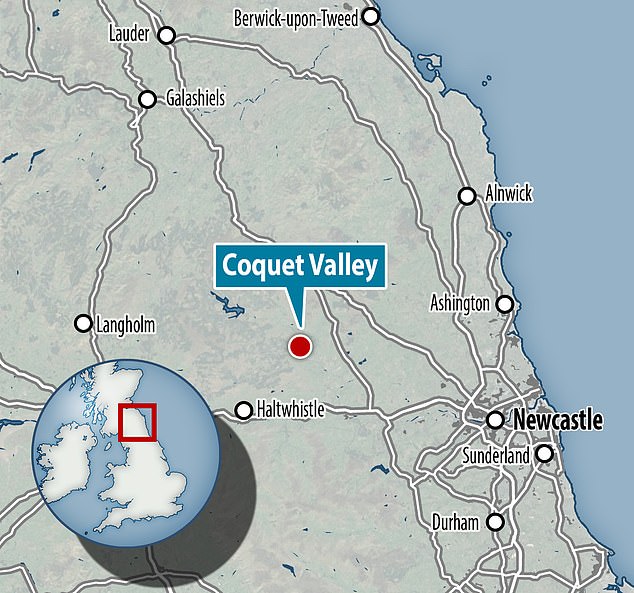
Dr Kershaw said the site is 'naturally defensive', making it a prime location for the Vikings to base themselves
